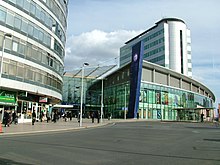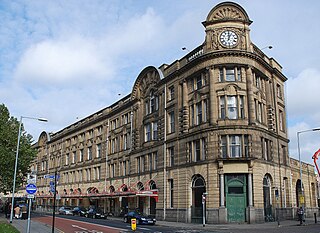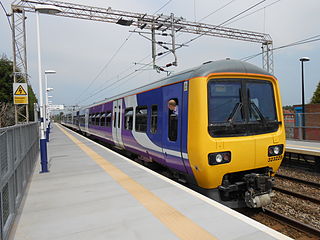 Aerial view of Piccadilly station in 2007 | |
| General information | |
| Location | Manchester, Greater Manchester England |
| Coordinates | 53°28′37″N2°13′48″W / 53.477°N 2.230°W |
| Grid reference | SJ847978 |
| Managed by | Network Rail |
| Transit authority | Greater Manchester |
| Platforms | 14 (National Rail) 2 (Manchester Metrolink) |
| Other information | |
| Station code | MAN |
| Fare zone | City (D) |
| Classification | DfT category A |
| Key dates | |
| 1842 | Opened as Store Street |
| 1847 | Renamed Manchester London Road |
| 1861 | Rebuilt |
| 1881 | Expanded |
| 1960 | Renovated and renamed Manchester Piccadilly |
| 2002 | Renovated |
| Passengers | |
| 2018/19 | |
| 2019/20 | |
| 2020/21 | |
| 2021/22 | |
| Interchange | 1.236 million |
| 2022/23 | |
| Interchange | |
Listed Building –Grade II | |
| Feature | Train shed at Piccadilly Station |
| Designated | 6 June 1994 |
| Reference no. | 1283014 [1] |
| Location | |
 | |
| Notes | |
Passenger statistics from the Office of Rail and Road | |
Manchester Piccadilly is the main railway station of the city of Manchester,in the metropolitan county of Greater Manchester,England. Opened originally as Store Street in 1842,it was renamed Manchester London Road in 1847 and became Manchester Piccadilly in 1960. Located to the south-east of the city centre,it hosts long-distance intercity and cross-country services to national destinations including London,Birmingham,Nottingham,Glasgow,Edinburgh,Cardiff,Bristol,Exeter,Plymouth,Reading,Southampton and Bournemouth;regional services to destinations in Northern England including Liverpool,Leeds,Sheffield,Newcastle and York;and local commuter services around Greater Manchester. It is one of 19 major stations managed by Network Rail. The station has 14 platforms:12 terminal and two through platforms (numbers 13 and 14). Piccadilly is also a major interchange with the Metrolink light rail system with two tram platforms in its undercroft.
Contents
- History
- Origins
- Manchester London Road
- Manchester Piccadilly
- Electrification
- Architecture
- Facilities
- Layout
- Services
- Avanti West Coast
- CrossCountry
- East Midlands Railway
- Northern Trains
- TransPennine Express
- Transport for Wales
- Piccadilly tram stop
- Metrolink services
- Future proposals
- Northern Hub
- High Speed 2
- Northern Powerhouse Rail
- References
- Citations
- Bibliography
- Further reading
- External links
Piccadilly is the busiest station in the Manchester station group with over 30 million passenger entries and exits between April 2019 and March 2020 (the other major stations in Manchester are Oxford Road and Victoria). As of December 2023,it is the third-busiest station in the United Kingdom outside of London (after Birmingham New Street and Leeds), [2] and is also one of the busiest interchange stations outside London,with over 2 million passengers changing trains annually. [3] The station hosts services from six train operating companies.
Between the late 1990s and early 2000s,Piccadilly station was refurbished,taking five years and costing £100 million (in 2002);it was the most expensive improvement on the UK rail network at the time. [4] Further improvements and expansion plans have been proposed. In December 2014,a Transport and Works Act application was submitted for the construction of two through platforms as part of the Manchester Piccadilly and Manchester Oxford Road Capacity Scheme. [5] [6] As of 2023,this application has not been approved by the incumbent government although Network Rail declared the Castlefield corridor through Manchester 'congested' in September 2019. [7] [8] [9]
















































